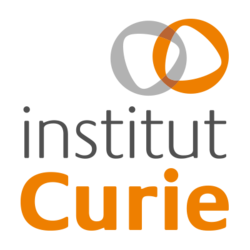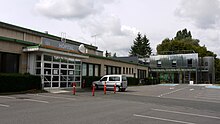

 | |
| Formation | 1920; 104 years ago (1920) |
|---|---|
| Type | Governmental organisation |
| Purpose | Fundamental research |
| Headquarters | 26 rue d'Ulm 75005 Paris |
Official language | French |
President | Thierry Philip |
| Website | institut-curie |

Institut Curie is a medical, biological and biophysical research centre in France.[citation needed] It is a private non-profit foundation operating a research center on biophysics, cell biology and oncology and a hospital specialized in treatmentofcancer. It is located in Paris, France.
Institut Curie is member of EU-LIFE, an alliance of leading life sciences research centres in Europe.[1]
The institute now operates several research units in cooperation with national research institutions CNRS and INSERM. There are several hundred research staff at the institute.[2] Institut Curie does not offer undergraduate degrees, but awards PhDs and employs many postdoctoral students alongside its permanent staff. Institut Curie is a constituent college (associate member) of University PSL.[3]
Institut Curie runs the Hôpital Claudius Régaud, a hospital specializing in cancer. The institute also operates the proton therapy center at Orsay, one of the few such facilities in the world.
The Institut du Radium, a giant laboratory for Marie Skłodowska–Curie, was founded in 1909 by the University of Paris and Institut Pasteur. The Institut du Radium had two sections. The Curie laboratory, directed by Maria Skłodowska-Curie, was dedicated to physics and chemistry research. The Pasteur laboratory, directed by Dr. Claudius Regaud, was studying the biological and medical effects of radioactivity. After receiving a joint Nobel Prize with her husband Pierre in 1903, Maria Skłodowska-Curie won a second Nobel Prize for Chemistry in 1911. During World War One, Maria Skłodowska-Curie used it to teach nurses about radiology.
Maria Skłodowska-Curie and Claudius Regaud established the Foundation Curie in 1920, a public interest institution. The Foundation's purpose was to fund the Institut du Radium's activities and contribute to the development of its therapeutic component. A first hospital opened in 1922. At the clinic, Dr. Regaud and his team developed innovative treatments combining surgery and radiation therapy to treat cancer. The Curie Foundation became a model for cancer centers around the world. Curie laboratory continued to play an important role in physics and chemistry research. In 1934, Maria Skłodowska-Curie's daughter Irène and her son-in-law Frédéric Joliot-Curie discovered artificial radioactivity. In 1935, it was recognized with a Nobel Prize in Chemistry. The Institut du Radium and the Fondation Curie merged in 1970. It became Institut Curie. The Institut has three missions: research, teaching and treating cancer. The original building of Curies Laboratory from 1914 now houses the Musée Curie.
Six Nobel prizes laureates (and four Nobel prizes) are attached to the Institute's researchers.
43% of all scientific women Nobel prize laureates from France (three prizes out of seven received by French women in "hard" sciences and Economy) to this day received them for research conducted at Institut Curie or its ancestor the Radium Institute. If Economy - a social science - is excluded, 50% i.e 3 Nobel Prizes out of 6 received by French scientific women are affiliated to the Curie Institute.
Hence why it is considered that, based on internationally recognised prizes garnered by its researchers, no other research center in the world has hosted that many pioneering women scientists.
Moreover, Marie Curie mentored upwards of 45 scientific women from all over the world[6][7][8][9] including Marguerite Perey, discoverer of francium - five-time nominee for the Nobel Prize in Chemistry, and Jeanne Ferrier, discoverer of autoradiography, amongst many other peers: Sonia Cotelle, Harriet Brooks, Alice Leigh-Smith, Eva Ramstedt, Lucie Blanquies, Suzanne Veil, Catherine Chamié, Alicja Dorabialska, Ellen Gleditsch, Marthe Weiss, Antonia Elisabeth Korvezee, May Sybil Leslie, Ștefania Mărăcineanu, Branca Edmée Marques, Eliane Montel, Elizabeth Rona, Jadwiga Szmidt, Margarete von Wrangell, Renée Galabert, Isabelle Archinard, and last but not least, Marie Curie's secretary of over 30 years: Léonie Razet.[10]
The Radium Institute also pioneered mobile radiography during World War I where upwards of 150 proto-nurses (nursing diploma in France only in 1922) and radiology pioneers where trained and even more post-war.[11][12]
Coworkers of the Curie Laboratory in the laboratory's library. From the left to the right, seated : Marguerite Perey, Léonie Razet, Isabelle, Archinard, Sonia Cotelle. Standing : André Régnier, Alexis Yakimach, Raymond Grégoire, Renée Galabert, Tchang Da Tcheng, Frédéric Joliot-Curie. In the Radium Institute of Paris, in 1930 (source : Musée Curie ; coll. Institut du Radium ; MCP1117)
Irène Curie and Marthe Klein with the radiology nursing students, at the Curie Laboratory, in the Radium Institute of Paris, in 1947 (source : Musée Curie ; coll. ACJC ; MCP1062).
At the end of war, Marie and Irène Curie have formed american military students to radiology before they go back home
|
| |
|---|---|
| Discoveries |
|
| Publications |
|
| Museums |
|
| Family |
|
| Namesakes |
|
| Depictions |
|
| International |
|
|---|---|
| National |
|
| Other |
|
48°50′36″N 2°20′39″E / 48.84333°N 2.34417°E / 48.84333; 2.34417